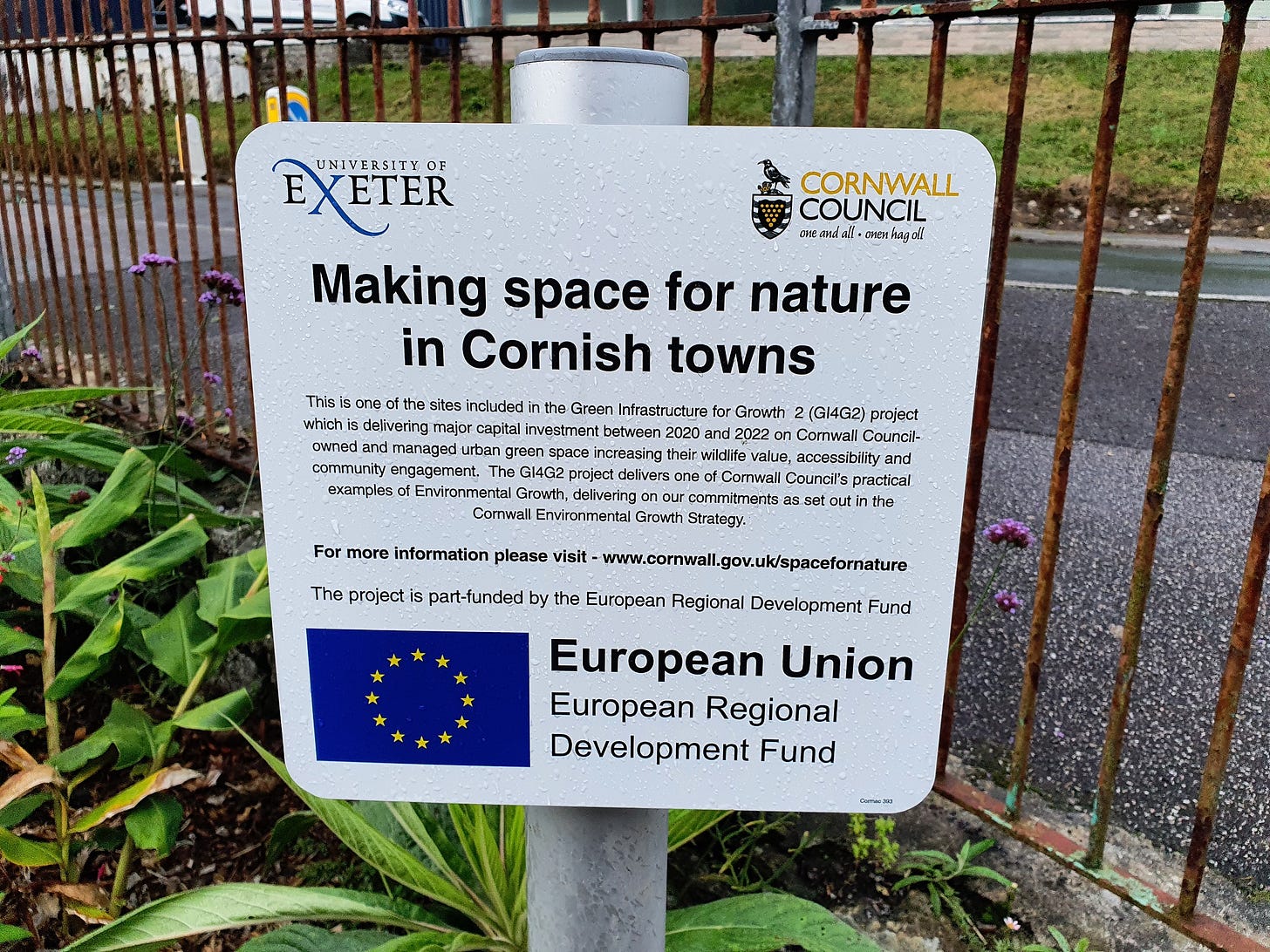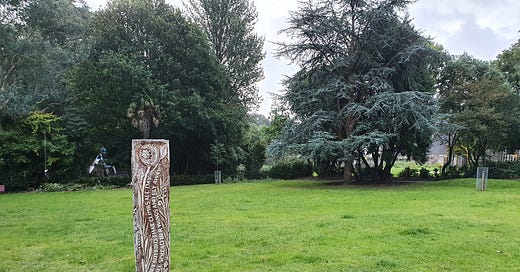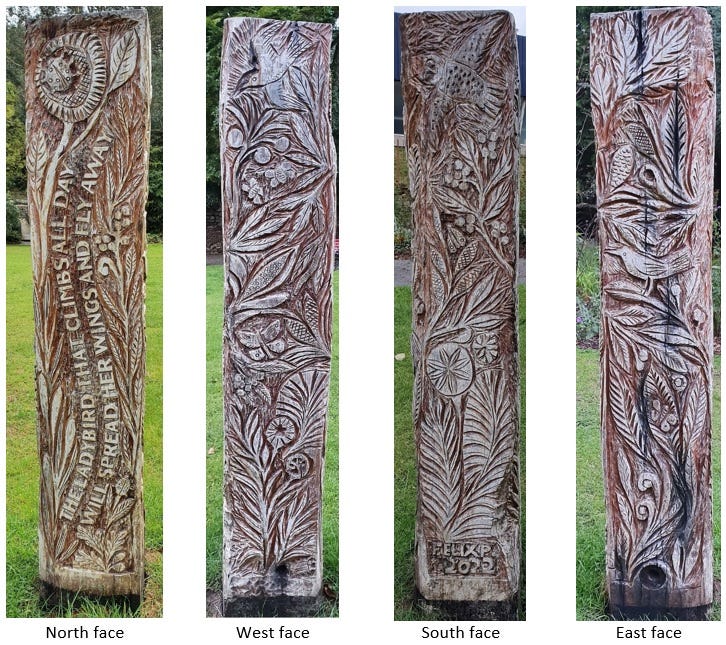Worked in Stone and the 'Penryn Pillar'
In which I attend a conference that changes how I see a sculpture in my home town
(NOTE: If I’ve misunderstood or misinterpreted anything presented at Worked in Stone, the resulting errors are entirely mine.)
I’ve been away from the blog for a little while, partly because I’ve been away from my desk for a little while.
More specifically I’ve been in Durham, at Worked in Stone, a conference to celebrate the Corpus of Anglo-Saxon Stone Sculpture, an immense and still-ongoing project to catalogue every piece of early medieval stone sculpture in England, initiated in 1977 by Professor Dame Rosemary Cramp.
As well as presentations on English sculpture, there were quite a few papers on stone sculpture from early medieval Scotland/Pictland, hence my decision to make the trip.
I was going to write a blog just summarising the conference and the sessions I’d particularly enjoyed. But on a rainy lunchtime walk through Penryn this week I happened to pass this recently installed monument, which stands in Trelawney Park at the western entrance to the town.
I remember tweeting about it in May this year when I first saw it. Back then, it struck me simply as a ‘beautiful’ piece of public art, created by one of my favourite local artists, Felix Packer.
But the sessions I attended in Durham introduced me to so many new ways of looking at and thinking about carved monuments that when I passed it this week, I saw it in a completely new light.
I thought it might be fun to write a blog applying what I’d learned in Durham to this pillar (which doesn’t seem to have an official name), and highlight some of the sessions that shaped this thinking.
A pillar carved in wood
So the first thing to say about it is that it’s not carved in stone, but in wood. That immediately brings to mind an excellent paper given by historian Professor John Blair (Queen’s College, Oxford), titled Stone Sculpture in a Wooden World.
Professor Blair reminded us that the stone sculpture that survives from early medieval Britain is likely only a small proportion of all sculpture created in the centuries between the departure of the Romans in 410 AD and the Norman conquest in 1066.
A lot (perhaps most) of it would have been made in wood—we can’t know how much because it hasn’t survived. But we can see hints of it, because some stone sculpture preserves techniques and tropes that come from wood carving, like the rings that support the cross-arms of free-standing high crosses.
As several speakers noted, the choice of stone or wood to create sculpture would have been largely driven by the natural resources available. One reason the Picts were able to create exceptionally fine stone sculpture—like the probably eighth-century Nigg Stone—was because they had easy access to large quantities of sandstone; one of the most rewarding types of stone to carve.
Here in Penryn the local stone is granite: great for building, but very tough to sculpt in any detail. The only surviving piece of medieval stone sculpture in the town is a small, plain cross. It’s likely that Felix Packer’s first-millennium forerunners in this part of Cornwall also mostly carved in wood.
Tall(ish) and carved on all four faces
The next thing to observe is that the pillar is (relatively) tall—about 1.75m—and carved on all four faces, implying it’s intended to be free-standing and experienced in the round.
That much is obvious in this case, because it stands in the place it was designed to stand. But the stone sculpture that survives from the first millennium AD is very rarely intact and still in its original setting. It’s usually been moved, broken up for building stone, smashed up in Viking raids or during the Reformation, used to mark or cover later graves, set into walls, or otherwise re-purposed.
In these instances, the size of the stone and the number and condition of its carved faces can provide clues as to its original setting and the ways in which it was intended to be experienced.
Dr Jill Hamilton Clements (University of Alabama at Birmingham) gave a thought-provoking paper on the original purpose of the carved ‘name stones’ found at Lindisfarne and other sites in Northumbria of old. Their size and weight make them portable: were they designed to be carried to the graveside during funeral processions? And being carved on one side only, and those carvings often unweathered, were they intended for interior wall-mounted display?

If the Penryn Pillar—as I’ve decided to call it—was removed from its position in Trelawney Park and re-discovered by archaeologists a thousand years hence, it might present similar challenges of interpretation. Would those archaeologists be able to deduce its original setting and purpose, or would it become an unfathomable mystery, like so much early medieval stone sculpture?
Imagery and inscriptions
Of course size, shape and condition aren’t the only clues. Carved monuments are a type of historical text: their images and inscriptions (where they exist) hold much of the key to their contemporary meaning. But with the passing of a thousand years or more, most or even all of that meaning can be lost, and become hard or impossible to recover.
After two centuries of speculation, nobody has been able to interpret the complex imagery on the ninth or tenth-century Sueno’s Stone, for example.
But even modern monuments resist interpretation without additional context. Looking at the Penryn Pillar without knowing anything about how it came to be here, I could make a few superficial deductions. The imagery on all four faces is of plants, flowers, birds and insects. There is an inscription on one face which, out of all of the motifs on the pillar, mentions only the ladybird.
Without deeper thought, my deductions might be that the theme is ‘nature’, that the north face with the inscription is the most important face, and that the ladybird is the most significant of all the elements.
In other words, with only itself for context, the Penryn Pillar might present to future archaeologists and historians the same kind of challenges of interpretation that a four-sided carved monument like the seventh or eighth-century Bewcastle Cross presents to early medievalists today.

In her paper at Worked In Stone, art historian Dr Meg Boulton (Edinburgh University) showed how carved standing crosses like those at Bewcastle and Easby were designed to transport the early medieval Christian viewer simultaneously back to the past and forward to the future.
The cross itself evokes the cross of the Crucifixion; a wooden structure originating from a living tree. This organic past is recalled in the climbing vine scroll that often adorns the sides of these crosses; vines which, as Dr Heather Pulliam (Edinburgh University) noted in the Q&A session, can be seen as growing towards the sun.
But it also seems certain that, rather than being the drab grey slabs we see today, early medieval stone crosses were brightly painted in jewel-like tones. Such decoration made them life-size versions of the crux gemmata (jewelled cross); a symbol widely used in the early middle ages to presage the New Jerusalem and Christ’s eternal victory.
Viewed against the sky, these towering, seemingly-jewelled stone crosses would speak to the viewer of possible future salvation in heaven, while their carved images of gnawing beasts—and sometimes more explicit imagery of the damned—would speak of eternal torment in hell.
A modern message of salvation and damnation
The Penryn Pillar is a secular monument, but perhaps its message to the modern viewer is not so different. Its carvings too recall its past as a living tree, with its vertically-oriented design programme including a sunflower and other leafy plants climbing towards the sun (and inhabited, like a lot of early medieval vine scroll, with birds and insects).
It also speaks to us of possible future salvation: not in Christ, but in the reversal of environmental collapse. The inscription explicitly asks us to consider the ladybird, who ‘climbs and climbs all day’ and ‘will spread her wings and fly away’.
A Google search brings up nothing for this couplet, making me think the artist came up with it himself. But, just as many early medieval sculptural motifs were designed to recall certain pertinent psalms, it does recall a very well known rhyme:
Ladybird, ladybird, fly away home / Your house is on fire and your children are gone.
In other words, we, the viewers of this sculpture, have a choice. We can achieve eternal salvation through care and respect for the natural world, or we can condemn insects, plants, birds, animals and ourselves to eternal damnation on a burning planet.
I’ve come a long way from my initial assessment of this pillar as just a ‘beautiful’ work of ‘public art’.
A vertical inscription: inspired by ogham?
And the parallels with early medieval sculpture don’t end there. I could point to the fact that the inscription on the Penryn Pillar is vertical; which, as Dr David Petts (Durham University) pointed out in his paper Early Inscribed Stones in Britain and Ireland, was an unusual but not unknown orientation in the early medieval period.
While most Roman and runic inscriptions were horizontal and designed to be read from left to right, inscriptions in ogham (or ogam) script were almost always carved vertically and designed to be read from bottom to top. Formed using notches along a stem line, ogham was invented in Ireland, but was also used to inscribe stones in Scotland, Wales, Devon and Cornwall.
I don’t know if Felix Packer had ogham script in mind when he carved the inscription on this pillar, but it would be fitting if he had. The ogham alphabet is grouped into four sets of five letters, with each set named after a tree, while the bottom-to-top reading reflects the direction of tree growth. That organic link is explicit in the Penryn inscription, which follows the growth of the sunflower and the ladybird’s journey to the top of it.

Mysterious and not-so-mysterious holes
And what about the two holes drilled into the base of the Penryn Pillar, on its east and west faces? Seeing these reminded me of a debate at Worked in Stone about the holes in the early medieval Hedda Stone in Peterborough Cathedral.
In her paper on icons in early English stone sculpture, Dr Teresa Porciani (Leicester University) suggested that these holes might be an integral part of the design—perhaps to hold candles that would flicker and make the figures seem to move.
(An audience member—I can’t now remember who—countered that they might already have been there, as the Hedda Stone is a piece of reused Roman building stone.)

The holes in the Penryn Pillar seem to me to be part of the design, intended to reinforce the pillar’s message to care for and respect the natural world. They’re surely meant to provide shelter for small creatures, as indicated by the carved stag beetle next to the hole at the base of the west face.
But would a future academic be able to recognise them as such—or would they be as stumped as modern scholars are about the holes in the Hedda Stone?
Power, politics and patronage
Finally, some thoughts on patronage. Early medieval sculptures were commissioned by patrons, just as they are today—and what those patrons chose to commission, and how it was presented, can provide clues to the power structures and political dynamics of the age.
In a keynote talk on Carved Stone Monuments as Political Actors in Early Medieval Britain, archaeologist Professor Martin Carver (University of York) described how the stone sculpture of northern Pictland reveals a ‘dynamic sequence’ in which power (and wealth) passed from the chiefs of local kindreds, to the founders of Christian monasteries, then to the rulers of the proto-kingdom of Alba.
My understanding of Prof Carver’s keynote is that each of these groups chose to communicate and consolidate their power through the raising of public sculpture; sometimes co-opting the symbols of power used by earlier or contemporary groups to reinforce and legitimise their own.
The sculpture produced in the eighth and ninth centuries at the monasteries at Portmahomack and Rosemarkie, for example, incorporated pre-Christian Pictish symbols that had been used—and perhaps were still in use—by chiefs of local kindreds to claim and mark their land.
Later, the patrons of the ninth or tenth-century Sueno’s Stone, which Professor Carver described as an expression of ‘secular conquest’ (he didn’t say by whom, but the prevailing view is that it was the Gaelic kings of Alba over the Picts), chose to incorporate in the design an enormous cross, perhaps to legitimise the conquest in the name of Christ and the church.

Penryn pillar patronage: it’s complicated
What might the patronage of the Penryn Pillar tell historians of the future about the power structures and political dynamics of our own times?
Identifying the patrons is easy—their logos obligingly appear on an ‘interpretation’ (perhaps more accurately ‘obfuscation’) plaque just a few metres away from the pillar:

But if I imagine this plaque being dug up a thousand years from now, I can begin to understand the challenges historians face in making sense of the scraps of written records that survive from the early medieval period—especially in Scotland, where only a tiny amount of writing has survived.
The language used here means very little even to me, as a contemporary, reasonably politically-literate observer. Removed from its context, it might be almost unintelligible to future historians.
They might discern some big themes: a focus on the natural environment; co-operation (and perhaps mutual legitimisation) between powerful academic and land-owning political institutions; the European Union as a source of wealth. But what might they make of a sentence like:
The GI4G2 project delivers one of Cornwall Council’s practical examples of Environmental Growth, delivering on our commitments as set out in the Cornwall Environmental Growth Strategy.
Although it wasn’t mentioned at Worked in Stone, I’m powerfully reminded of the ongoing debate over a single sentence in the tenth-century Chronicle of the Kings of Alba, which records that in 906 AD:
King Constantín and Bishop Cellach vowed—on the Hill of Belief near the royal civitas of Scone, after the fashion of the Gaels—to keep the laws and disciplines of the faith and also the rights of churches and the Gospels; from this day the hill has received its name, that is, the Hill of Belief.
This statement no doubt made sense in its own time, even if only to people intimately involved in the politics of the day. But for us now, at 1,100 years’ remove and with little else to go on, it serves to confuse more than enlighten.
The early Middle Ages: more impenetrable than I thought
What I’m coming to realise, through studying early medieval Scottish history and attending conferences like Worked in Stone, is that no matter how hard we try to understand them, a great many aspects of the early Middle Ages will forever remain a mystery.
I used to think there might be some sort of ‘key’ to unlock it all: if only we could work out what the Pictish symbols mean, or what the ogham inscriptions on Pictish stones say, we would know exactly what was going on in Scotland in the first millennium.
But seeing academic after academic scratching their heads over tiny puzzles—like why the Hedda Stone has holes in it, or what the Hartlepool name stones were for—and drawing on years of research to suggest tentative solutions, I realise how naïve I was.
When I come to do my MA research on Sueno’s Stone: who commissioned it, for what purpose, and why it was situated in Forres, I can’t expect to make any great leaps forward in understanding this perpetually mysterious monument. Rather than aiming for some great revelation, I’ve revised my ambitions downwards. If I can uncover something that wasn’t already known or thought about it, that would be enough for me.
And maybe a thousand years from now, a fledgling academic will be thinking exactly the same about an ancient and mysterious carved wooden pillar recently recovered from a post-apocalyptic Penryn.
References
Worked in Stone papers
J. Blair, Stone sculpture in a wooden world
M. Boulton, “Living in a material world”: considering a phenomenology of ornament in early medieval stone sculpture
M. Carver, Carved stone monuments as political actors in early medieval Britain
J. Hamilton Clements, Having the dead in hand: inscription, movement and display in early medieval Northumbria
D. Petts, Words and no pictures: design and influence in early inscribed stones in Britain and Ireland
T. Porciani, Icons in stone: image, worship and controversy in early medieval England, c. 700–850
Other references
A. Woolf, From Pictland to Alba, 789-1070 (Edinburgh University Press, 2007)





